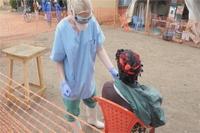-
Epidemics do not require long-distance travel by virus carriers to spread
The current Ebola outbreak shows how quickly diseases can spread with global jet travel. Yet knowing how to predict the spread of these epidemics is still uncertain, because the complicated models used are not fully understood. Using a very simple model of disease spread, UC Berkeley biophysicist Oskar Hallatschek proved that one common assumption is actually wrong. Most models have taken for granted that if disease vectors, such as humans, have any chance of “jumping” outside the initial outbreak area — by plane or train, for example – the outbreak quickly metastasizes into an epidemic. Hallatschek and colleagues found instead that if the chance of long-distance dispersal is low enough, the disease spreads quite slowly, like a wave rippling out from the initial outbreak. This type of spread was common centuries ago when humans rarely traveled. The Black Death spread through fourteenth-century Europe as a wave, for example.
-
-
Alternative to antibiotics
Ever since the development of penicillin almost ninety years ago, antibiotics have remained the gold standard in the treatment of bacterial infections. The World Health organization (WHO), however, has repeatedly warned of a growing emergence of bacteria that develop antibiotic resistance. Once antibiotics do no longer protect from bacterial infection, a mere pneumonia might be fatal. Scientists from the University of Bern have developed a novel substance for the treatment of severe bacterial infections without antibiotics, which would prevent the development of antibiotic resistance.
-
-
U.S. will see between 1 and 130 additional Ebola cases by end of 2014: Experts

Top U.S. medical experts studying the spread of Ebola predict a few more cases will reach America before year’s end, citing the return of healthcare workers currently working in West Africa as the most likely cause of new cases. Using data models that weigh several variables including daily new infections in West Africa, global airline traffic, and transmission possibilities, top infectious disease experts predict as few as one or two additional infections and as many as 130 by the end of 2014.
-
-
Hungarian red mud spill did little long-term damage

The aftereffects of the 2010 red mud spill that threatened to poison great swathes of the Hungarian countryside have turned out to be far less harmful than scientists originally feared. The disaster happened when weeks of heavy rain caused a dam to collapse at a containment facility in Ajka in Western Hungary. It released around a million cubic meters of toxic sludge into the Torna-Marcal river system, onto the Hungarian plain and ultimately into the Danube. The mud, a byproduct of refining aluminum from bauxite ore, was dangerously alkaline, extremely salty and contained potentially toxic metals like chromium and vanadium.
-
-
Rate of infection in West Africa has begun to slow down

Public health officials monitoring the Ebola epidemic in West Africa say the outbreak may have reached a turning point in which transmissions may have begun to slow down. Dr. Jeremy Farrar, director of the Wellcome Trust, the organization funding a series of fast-tracked trials of Ebola vaccines and drugs, says that although the virus will continue to infect people in the months ahead, “it is finally becoming possible to see some light.”
-
-
Infection outbreaks, unique diseases on the increase since 1980
Ebola has a lot of company. In a novel database now made publicly available, researchers found that since 1980 the world has seen an increasing number of infectious disease outbreaks from an increasing number of sources. The good news, however, is that they are affecting a shrinking proportion of the world population. The number of infectious disease outbreaks and the number of unique illnesses causing them appear to be increasing around the globe, with more than 12,000 outbreaks affecting forty-four million people worldwide over the last thirty-three years.
-
-
Lack of federal authority makes fashioning coherent national Ebola policy difficult

Earlier this week, the Centers for Disease Control and Prevention(CDC) issued new guidelines on how states should deal with travelers from Ebola-stricken regions, but a lack of federal authority to mandate such guidelines has led to conflicting strategies, varying from state to state, which includes mandatory at-home quarantine for some travelers. Under current U.S. law, the states have the authority to issue quarantine or isolation policies, and they also control the enforcement of these policies within their territories.
-
-
Infection projections: how the spread of Ebola is calculated
Ebola is an example of an emerging infectious disease (EID): one that has newly appeared in a population or has undergone a rapid increase in incidence. Bioinformatics plays a key role in detecting, monitoring and responding to EIDs. In the case of Ebola, the bioinformatics community has responded rapidly. For example, the current outbreak of Ebola in Sierra Leone was first detected in May, but by September a study reported sequencing 99 Ebola virus genomes from 78 patients diagnosed with the disease between late May and mid-June. Bioinformaticians have been developing and refining algorithms for sequence assembly since the late 1980s, and are constantly adapting them so they can handle new sequencing technologies and ever-larger scales of assembly. Bioinformatics is, and will continue to be, a core component of the international response to Ebola and other EIDs, and patients, medical staff and those close to them need all the help they can get.
-
-
Legality of mandatory quarantine of asymptomatic individuals questioned
Roughly three decades ago, patients in New York were forced into isolationafter an outbreak of tuberculosis, and about seventy years before that, an influenza pandemic led to mass quarantine in major American cities. Today, fear of an Ebola outbreak in the United States has led some states to mandate quarantine of individuals suspected of having the Ebola virus, but legal analysts question the legality of such measures.
-
-
Experts consider implications of Ebola strain being stolen from lab
As the Ebola virus continues to plague several Americans and Europeans and thousands in Africa, researchers are beginning to examine the outcomes should a strain of Ebola be stolen from a testing laboratory. Many scientists in U.S. labs study the Ebola virus in order to find out how they can fight it. They wonder, however, what set of procedures are in place if a sample of the virus was stolen.
-
-
Insurance companies now write Ebola exclusions into policies; offer Ebola-related products
U.S. and British insurance companies have begun to write Ebola exclusions into their policies for hospitals, event organizers, airliners, and other businesses vulnerable to disruption from the disease. As a result, new policies and renewals will become more expensive for firms looking to insure business travel to West Africa or to cover the risk of losses from Ebola-driven business interruptions (BI).The cost of insuring an event against Ebola, for example, would likely be triple the amount of normal cancellation insurance — if the venue was in a region not known to be affected by the virus.
-
-
Private cleaning firms had to improvise when cleaning apartments of U.S. Ebola patients

Officials responsible for disinfecting the Ebola-infected homes of Thomas Eric Duncan’s fiancee, and of the two nurses he infected, relied on best decontamination practices, but note that an official manual for responding to a home contaminated with the Ebola virus was nonexistent at the time. OSHA recently announced official guidelines for “Cleaning and Decontamination of Ebola on Surfaces” for workers and employers in non-healthcare/non-laboratory settings.
-
-
First New York Ebola case confirmed
Dr. Craig Spencer, who had been working with Doctors without Borders in Guinea and treating Ebola patients before returning to New York City on 14 October, was taken to Bellevue Hospital yesterday (Thursday) and placed in strict isolation. Tests later determined that he had contracted the Ebola virus. Spencer is the first New Yorker diagnosed with Ebola. As if in anticipation of a case like Dr. Spencer’s, more than 5,000 healthcare workers in New York participated in a three-hour session earlier this week to prepare for Ebola should an infected person arrive in the New York City region.
-
-
RMS develops probabilistic model of West African Ebola outbreak
Current outbreak has the potential to be the deadliest infectious disease event since the 1918 flu pandemic. The outbreak will worsen and could reach as many as 1,400 new cases per day within a month, according to pandemic risk experts. According to a new model developed by RMS, until a tipping point is reached at which the number of new daily cases declines rather than increases, the severity of the outbreak will continue to multiply, with the total number of new cases approximately doubling each month.
-
-
Ebola kills, but it may be immunizing others at the same time
As Ebola continues to spread in West Africa, it may be silently immunizing large numbers of people who never fall ill or infect others, yet become protected from future infection. If such immunity is confirmed, it would have significant ramifications on projections of how widespread the disease will be and could help determine strategies that health workers use to contain the disease.
-
More headlines
The long view
Ransomware Attacks: Death Threats, Endangered Patients and Millions of Dollars in Damages
By Dino Jahic
A ransomware attack on Change Healthcare, a company that processes 15 billion health care transactions annually and deals with 1 in 3 patient records in the United States, is continuing to cause massive disruptions nearly three weeks later. The incident, which started on February 21, has been called the “most significant cyberattack on the U.S. health care system” by the American Hospital Association. It is just the latest example of an increasing trend.
